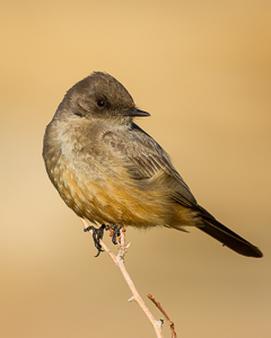SAY'S PHOEBE OR-192
Malheur National Wildlife Refuge, southeastern Oregon
June 10, 4:44 a.m.
Sunrise at 5:14 a.m.
A Say's phoebe at dawn. Very nice--wonderful songs. I first heard a Say's phoebe riding under the early morning streetlights through Pueblo, Colorado; I listened carefully to the daytime songs in Hell's Canyon; and now I come to a surprise that I hadn't expected in the dawn songs of this particular Say's phoebe.
This male has the same two songs that I heard during the day in Hell's Canyon: what I called the pit-TSEEeeuur song (say, A), distinctively down-slurred and instantly recognizable; and the raspy, rising prrrREEP (call it B). But this male has a third song (C; pit-urr-EE-EEP); it also rises, but is tonal, not raspy. It's the fifth and twelfth song in this series, for example.
The first five songs in this recording are as follows: pit-TSEEeeuur, pit-TSEEeeuur, prrrREEP, pit-TSEEeeuur, pit-urr-EE-EEP.
Using letters to identify the songs, I lay out this male's song performance, in 30-second segments, with a song nearly every second:
A A B A C A B A A B A C A B A A B A C A B A C A A B
A A B A C A B A A B A A B A C A B A C A B A A B A C
A A B A A B A C A B A A B A C A B A C A B A A A B A
C A B A A B A C A B A A B A C A B A A A B A C A B
A A A B A C A B A A B A C A B A A B A C A A B A A
B A A B A C A B . . .
His most common song is the pit-TSEEeeuur (80 occurrences), followed by the prrrREEP (37) and the pit-urr-EE-EEP (19). His pit-TSEEeeuur song (A) anchors the song performance, and whenever he sings either the B or C song, he always returns to A, with B and C never occurring together.
I need to listen to more Say's phoebes. My sample of two feels insufficient, with the one daytime bird at Hell's Canyon singing songs A and B, this dawn bird in eastern Oregon singing A, B, and C. Do all Say's phoebes use song C only at dawn, much like the eastern wood-pewee reserves his ah-di-dee song for dawn and dusk singing; but then I note that the eastern phoebe, a close relative of the Say's phoebe, uses his same two songs both at dawn and during the day. Because flycatchers don't learn their songs, all the individuals of one species will sing very much alike, so it's my best guess that these two Say's phoebes have taught me what all others of their kind also do.
Background
A common nighthawk peents and VROOMs; western kingbird in dawn song, barn swallows flying by.

Photo by Wil Hershberger
